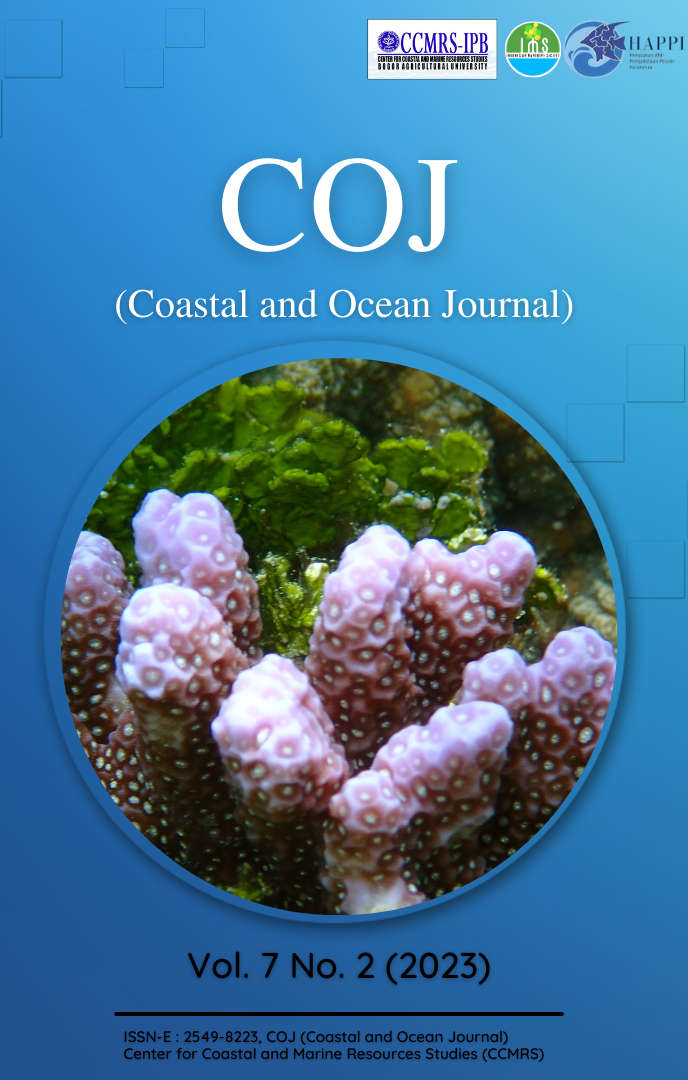BIOACTIVE COMPOUNDS, PHENOL CONTENT AND ANTIOXIDANT ACTIVITY OF TROPICAL SEAGRASS Halodule pinifolia
Abstract
Intertidal seagrasses are exposed to a high level of sunlight, temperature, and desiccation daily, which can lead to increase in reactive radical species producing. In order to survive, they may produce some bioactive compounds and may change the content of nutrient and non-nutrient. In this experiment, tropical seagrass Halodule pinifolia collected from the coastal area of Pangumbahan Sukabumi Indonesa was evaluated their potential nutritional value and natural antioxidant compound. Fresh seagrass H. pinifolia contained ash, protein and fat of 14.89, 9.74 and 2.13 g/100 g dry matter; whereas the amounts of soluble dietary fiber, insoluble dietary fiber were 12.84 and 27.23 g/100 g dry matter, respectively. The highest content of total phenol was found in ethyl acetate extract (0.31 mg GAE/g dry matter), followed by methanol and hexane extracts of 0.18 and 0.12 mg GAE/g dry matter, respectively. The extract of ethyl acetate also had the highest activity on DPPH-scavenging measured by IC50 value of 214.38 ppm in compared to methanol and hexane extracts. All of extracts contained bioactive compounds of steroid, flavonoid and phenol hydroquinone; whereas triterpenoid was only found in the extract of hexane.
Downloads
References
[AOAC] Association of Official Analytical Chemist. 2005. Official Method of Analysis of the Association of Official Analytical of Chemist. The Association of Official Analytical Chemist, Inc., Washington, D.C. 1899 pp.
Aranda, R.S., L.A.P. Lopez, J.L. Arroyo, B.A.A. Garza, and N.W. Torres. 2009. Antimicrobial and antioxidant activities of plants from Northeast of Mexico. Evidence-Based Complement Alternative Medicine, 20(11): 1-6.
Athiperumalsamy, T., V. Kumar, and L. Jessudas. 2008. Survey and phytochemical analysis on seagrasses in the Gulf of Mannar, southeast coast of India. Botanica Marina, 51: 269-277.
Athiperumalsamy, T., D. Rajeswari, S.H. Poorna S, V. Kumar, and L. Jessudas. 2010. Antioxidant activity of seagrasses and seaweeds. Botanica Marina, 53: 251-257.
Benjama, O., and P. Masniyom. 2012. Biochemical composition and physicochemical properties of two red seaweeds (Gracilaria fisheri and G. tenuistipitata) from the Pattani Bay in Southern Thailand. Songklanarin J. of Science and Technology, 34(2): 223-230.
Bitam, F., M.L. Ciavatta, M. Carbone, M. Ernesto, and M.M. Gavagnin. 2010. Chemical analysis of flavonoid constituents of the seagrass Halophila stipulacea: First finding of malonylated derivatives in marine phanerogams. Biochemical Systematics and Ecology, 38: 686-690.
Chen, Y., L. Cai, C. Zhao, H.C. Xu, C.Y. Cao, and Y. Liu. 2008. Spectroscopic, stability and radical scavenging properties of a novel pigment from Gardenia. Food Chemistry, 109: 269-277.
Duan, X.J., W.W. Zhang, X.M. Li, and B.G. Wang. 2006. Evaluation of antioxidant property of extract and fractions obtained from a red alga, Plysiphonia urceolata. Food Chemistry, 95: 37-43.
Dumay, O., J. Costa, J.M. Desjobert, and G. Pergent. 2004. Variation in the concentration of phenolic compounds in the seagrass Posidonia oceania under condition of competition. Phytochemistry, 65: 3211-3220.
Elleuch, M., D. Bedigian, O. Roiseux, S. Besbes, C. Blecker, and H. Attia. 2011. Dietary fibre and fibre-rich by-products of food processing: Characterization, technological functionality and commercial applications: A review. Food Chemistry, 124: 411-421.
Gavin, N.M., and M.J. Durako. 2011. Localization and antioxidant capacity of flavonoids from intertidal and subtidal Halophila johnsonii and Halophila decipiens. Aquatic Botany, 95: 242-247.
Gillan, F.T., R.W. Hogg, and D.E. Drew. 1984. The sterol and fatty acid composition of seven tropical seagrasses from North Quensland Australia. Phytochemistry, 23: 2817-2821.
Gomez-Ordonez, E., A. Jimenez-Escrig, and P. Ruperez. 2011. Dietary fibre and physicochemical properties of several edible seaweeds from the northwestern Spanish coast. Food Research International, 43: 2289-2294.
Harborne, J.B. 1987. Phytochemical Methods 2nd edition. Chapman and Hall, New York. 184 p.
Heglmeier, A., and C. Zidorn. 2010. Secondary metabolites of Posidonia oceania (Posidoniaceae). Biochemical Systematics and Ecology, 38: 964-970.
Iyapparaj, P., P. Revathi, R. Ramasubburayan, S. Prakash, A. Palavesam, G. Immanuel, P. Anantharaman, A. Sautreau, and C. Helli. 2014. Antifouling and toxic properties of the bioactive metabolites from the seagrasses Syringodium isoetifolium and Cymodocea serrulata. Ecotoxicology and Environmental Safety, 103: 54-60.
Jimenez-Escrig, A., and F. Sanchez-Muiz. 2000. Dietary fibre from edible seaweeds: Chemical structure, physicochemical properties and effects on cholesterol metabolism. Nutrition Research, 20(4): 585-598.
Kannan, R.R.R., R. Arumugam, and P. Anantharaman. 2010. In vitro antioxidant activities of ethanol extract from Enhalus acoroides (L.F.) Royle. Asian Pacific J. of Tropical Medicine, 898-901.
Kannan, R.R.R., R. Arumugam, and P. Anantharaman. 2012. Chemical composition and antibacterial activity of Indian seagrasses against urinary tract pathogens. Food Chemistry, 135: 2470–2473.
Kannan, R.R.R., R. Arumugam, P. Iyapparaj, T. Thangaradjou, and P. Anantharaman. 2013. In vitro antibacterial, cytotoxicity and haemolytic activities and phytochemical analysis of seagrasses from the Gulf of Mannar, South India. Food Chemistry, 136: 1484-1489.
Langseth, L. 2000. Antioxidant and their effect on health. In: Schmidl, M.M., and T.P. Labuza (eds.). Essential of Functional Foods. Aspen Publisher Inc., Gaithersburg, Maryland. pp. 303-317.
Mabeau, S., and J. Fluerence. 1993. Seaweeds in food products: Biochemical and nutritional aspects. Trends in Food Science and Technology, 4:103-107.
McMillan, C. 1984. The contensed tannins (proanthocyanidin) in seagrasses. Aquatic Botany, 20: 351-357.
Meng, Y., A.J. Krzysiak, M.J. Durako, J.I. Kunzelman, L.C. Jeffrey, and J.L.C. Wright. 2008. Flavones and flavone glycosides from sea grass Halophila johnsonii. Phytochemistry, 69: 2603-2608.
Molyneux, P. 2004. The use of the stable free radical diphenylpicryl-hydrazil (DPPH) for estimating antioxidant activity. Songklanarin J. of Science and Technology, 26(2): 211−219.
Montano, N.M.E., R.S. Bonaficao, and R.G.O. Rumbaoa. 1999. Proximate analysis of the flour and starch from Enhalus acaroides (L.f) Royle seeds. Aquatic Botany, 65:321-325.
Nisizawa, K., H. Noda, R. Kikuchi, and T. Watanabe. 1987. The main seaweeds in Japan. Hydrobiology, 151/152: 5-29.
Nisizawa, K. 2002. Seaweeds Kaiso. Bountiful harvest from the seas. Sustenance for Health and Well Being by Preventing Common Life-style Related Diseases. Japan Seaweed Association, Kochi. 105 p.
Ortiz, J., N. Romero, P. Robert, J. Araya, J. López-Hernández, C.E. Bozzo,C.E. Navarrete, A. Osorio, and A. Rios. 2006. Dietary fiber, amino acid, fatty acid and tocopherol contents of the edible seaweeds Ulva lactuca and Durvillaea antartica. Food Chemistry, 99: 98-104.
O’Sullivan, A.M., Y.C. O’Callaghan, M.N. O’Grady, B. Queguineur, D. Hanniffy, D.J. Troy, J.P. Kerry, and N.M. O’Brien. 2011. In vitro and cellular antioxidant activities of seaweed extracts prepared from five brown seaweeds harvested in spring from the west coast of Ireland. Food Chemistry, 126: 1064-1070.
Plaami, S., M. Saastamoinen, and J. Kumpulainen. 1989. Effect of variety of environment on dietary fiber content of winter rye in Finland. J. of Cereal Science, 10: 209-215.
Prakash, D., G. Upadhyay, B.N. Singh, and H.B. Singh. 2007. Antioxidant and free radical-scavenging activities of seeds and agri-wastes of some varieties of soybean (Glycine max). Food Chemistry, 104: 783-790.
Prosky, L., N.G. Asp, T.F. Schweizer, J.W. DeVries, and I. Furda. 1988. Determination of insoluble and total dietary fiber in foods and food product: Intercollaborative study. J. of Association Official Analytical Chemist, 71: 1017-1023.
Ramadhan, W., Uju, Hardiningtyas, SD., Pari., Nurhayati, Sevica, D. 2022a. Ultrasonic wave assisted extraction of ulvan polysaccharide from Ulva lactuca seaweed at low temperature. JPHPI, 2(1): 132-142
Ramadhan, W., Khoirunnisa Z., Uju, Tarman K., Oktaviarty V., Meydia. 2022b. Meta-analysis on the effect of ingredients on chemical quality of nori-like product. COJ (Coastal and Ocean Journal). 6(2): 63-72.
Rengasamy, R.R.K., A. Radjassegarin, and A. Perumal. 2013. Seagrasses as potential source of medicinal food ingredients: Nutritional analysis and multivariate approach Biomedicine & Preventive Nutrition, 3(4): 375-380.
Santoso, J., Y. Yoshie, and T. Suzuki. 2002. The distribution and profile of nutrients and catechins of some Indonesian seaweeds. Fisheries Science, 68 (suppl): 1647-1648.
Santoso, J. 2003. Studies on nutritional components and antioxidant activity in several Indonesian seaweeds [dissertation]. Tokyo University of Fisheries, Tokyo. 119 p.
Santoso, J., Y. Yoshie, and T. Suzuki. 2004a. Antioxidant activity of methanol extracts from Indonesian seaweeds in an oil emulsion model. Fisheries Science, 70: 183-188.
Santoso, J., Y. Yoshie, and T. Suzuki. 2004b. Polyphenolic compounds from seaweeds: Distribution and their antioxidative effects. Development in Food, 42: 169-177.
Santoso, S., S. Gunji, Y. Yoshie-Stark, and T. Suzuki. 2006. Mineral content of Indonesian seaweeds and mineral solubility affected by basic cooking. Food Science and Technology Research, 12(1): 59-66.
Santoso, J., S. Anwariyah, R.O. Rumiantin, A.P. Putri, N. Ukhty, and Y. Yoshie-Stark. 2012. Phenol content, antioxidant activity and dietary fiber profile of four tropical seagrasses from Indonesia. J. Coastal Development, 15(2): 189-196.
Santoso, J., F. Podungge, and H. Sumaryanto. 2013. Chemical composition and antioxidant activity of tropical brown alga Padina australis from Pramuka Island – District of Seribu Island, Indonesia. J. Ilmu dan Teknologi Kelautan Tropis, 5(2): 287-297.
Soobrattee, M.A., V.S. Neergheen, A. Luximon-Ramma, O.I. Arouma, and T. Bahorun. 2005. Phenolic as potential antioxidant therapeutic agents: Mechanism and actions. Mutation Research, 579: 200-213.
Sureda, A., A. Box, J. Terrados, S. Duedero, and A. Pons. 2008. Antioxidant responses of the seagrass Posidonia oceania when epiphytized by the invasive macroalgae Lophlocladia lallemandii. Marine Environmental Research, 66: 359-363.
Suzuki, T., Y. Ohsugi, Y. Yoshie, T. Shirai, and T. Hirano. 1996. Dietary fiber content, water-holding capacity and binding capacity of seaweeds. Fisheries Science, 62: 454-461.
Viso, A.C., D. Pesando, P. Bernard, and J.C. Marty. 1993. Lipid components of the Mideterranean seagrass Posidonia oceania. Phytochemistry, 34(2): 381-381.
Yaich, H., H. Garna, S. Besbes, M. Paquot, C. Blecker, and H. Attia. 2011. Chemical composition and functional properties of Ulva lactuca seaweed collected in Tunisia. Food Chemistry, 128: 895-901.
Yangthong, M., H.T. Nongporn, and W. Phromkunthong. 2009. Antioxidant activities of four edible seaweeds from the southern coast of Thailand. Plant Foods Human Nutrition, 64: 218-223.
Yoshie, Y., W. Wang, D. Petillo, and T. Suzuki T. 2002. Distribution catechins in Japanese seaweeds. Fisheries Science, 66: 998-1000.
Yoshie-Stark, Y., Y.P. Hsieh, and T. Suzuki. 2003. Distribution of flavonoids and related compounds from seaweeds in Japan. J. Tokyo University of Fisheries, 89: 1-6.
Yu-Tang, T., C. Jyh-Horng, H. Ch-Chang, P. Hsiang-Chi, C. Ya-Ling, and Y. Suh-Ching. 2009. Protective effect of acacia confuse bark extract and its active compound gallic acid against carbon tetrachloride-induced chronic liver injury in rats. Food Chemistry and Toxicology, 47: 1385-1392.





